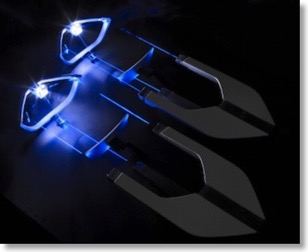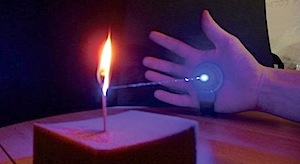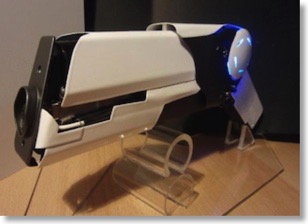Home
A comprehensive resource for safe and responsible laser use
Germany: Laser/aircraft incidents decline 12.4% compared to last year
This decrease is despite a doubling of incidents at Frankfurt International Airport. In the first half of 2018 there were 22 laser illuminations versus only 11 during the same period in 2017.
Declines were reported at Munich, Hamburg and Stuttgart airports.
A spokesperson for the German pilots' union Vereinigung Cockpit seemed to indicate that increasing prosecutions were a cause of the drop from 2017 to 2018: "A few years ago, the laser attack was a hip prank for some young people. The perpetrators must now be aware that they are consistently prosecuted."
From DW.com reporting on a story from public broadcast service ARD. Thanks to Greg Makhov for bringing this to our attention.
Germany: Scientific study of laser pointer eye injuries finds 111 cases
Background: Recent years have seen a marked increase in laser-pointer-related injuries, which sometimes involve severe retinal damage and irreversible visual impairment. These injuries are often caused by untested or incorrectly classified devices that are freely available over the Internet.
Methods: We reviewed pertinent publications retrieved by a systematic search in the PubMed and Web of Science databases and present our own series of clinical cases.
Results: We identified 48 publications describing a total of 111 patients in whom both acute and permanent damage due to laser pointers was documented. The spectrum of damage ranged from focal photoreceptor defects to macular foramina and retinal hemorrhages associated with loss of visual acuity and central scotoma. On initial presentation, the best corrected visual acuity (BCVA) was less than 20/40 (Snellen equivalent) in 55% of the affected eyes and 20/20 or better in 9% of the affected eyes. Treatment options after laser-pointer-induced ocular trauma are limited. Macular foramina and extensive hemorrhages can be treated surgically. In our series of 7 cases, we documented impaired visual acuity, central visual field defects, circumscribed and sometimes complex changes of retinal reflectivity, and intraretinal fluid. Over time, visual acuity tended to improve, and scotoma subjectively decreased in size.
Conclusion: Laser pointers can cause persistent retinal damage and visual impairment. In view of the practically unimpeded access to laser pointers (even high-performance ones) over the Internet, society at large now needs to be more aware of the danger posed by these devices, particularly to children and adolescents.
From Birtel J, Harmening WM, Krohne TU, Holz FG, Charbel Issa P, Herrmann P. Retinal injury following laser pointer exposure—a systematic review and case series. Dtsch Arztebl Int, 2017 DOI: 10.3238/arztebl.2017.0831. Original in German, translation in English.
Germany: 261 laser/aircraft incidents in 2012
This information was given by a spokesperson for Berlin Tegel airport, speaking after a September 8 2013 incident where a 14-year-old boy aimed a laser at three airplanes landing at the airport.
From BZ-Berlin (original German text and Google-translated English text)
Europe: 4,266 laser incidents; harmonized criminal laws sought
In 2008, there were 1,048 European incidents.
A Eurocontrol safety expert said “Preventing and mitigating the current problem requires a harmonized approach throughout Europe. We need the full involvement of regulators, judicial authorities, police, airlines and their associations, air navigation service providers, laser manufacturers who must understand how serious the problem is, as well as research institutes.”
Most European countries do not have specific laws against aiming lasers at aircraft. Eurocontrol stated they should be subject to the same restrictions as firearms, covering the purchase, transportation and use of lasers.
German politician Volker Kauder said that high-powered lasers should be treated as weapons under the Geman Arms Act.
From the Washington Post
Germany: BMW shows safety features of its new laser headlights
Each of the four headlights uses three blue lasers. The lasers are directed by mirrors onto a lens containing yellow phosphorus. This re-emits white light onto a larger mirror that reflects it out the headlight glass onto the road.

Two of the four laser headlights are shown here. The resulting white light beam is emitted toward the upper left of the photo.
The system is 1000 times brighter than LED headlights, uses half the power, lasts just as long (10,000 hours) and allows more flexible designs. BMW noted that light emitted from the headlights is not laser light, and is safe to stare into. In case of an accident, the headlights are powered down so no laser light could escape.
[Note from LaserPointerSafety.com: It is likely that the laser diodes in the headlight are the same type used in Casio’s Green Slim projectors and the Wicked Laser Spyder III Arctic handheld laser. These are relatively inexpensive -- less than $30 each in quantity -- and produce a nominal 1 watt of light.]
From Motor Trend
Germany: "Iron Man" laser fires Class 4 beam from a hobbyist's palm
Hobbyist Patrick Priebe’s inspiration was the comic book character “Iron Man”, who has “repulsor rays” in the palms of his armor’s gloves. Priebe’s device is self-contained, with the battery in a case that wraps around the back of the hand. Simply flexing his hand triggers the beam to fire.

Priebe’s 1 watt, 445 nm blue laser beam ignites a match
His inspiration: Iron Man’s repulsor ray glove, as seen here in the motion picture with Robert Downey, Jr.
Priebe made a number of versions. He is selling limited numbers (not mass-produced) of kits and assembled gloves on laser pointer forums for $200-500 depending on the version.
From Popular Science and many other sources. Details on the construction are at Hacked Gadgets. Videos of the device in action are here and here.
Germany: 273 (or 388) incidents in 2010; call for ban on pointers
He recommended fast action. He discussed a European import ban, as well as classifying lasers as a weapon, and prohibiting private possession of Class 3 and Class 4 lasers. He said, “I call on the competent authorities to submit to the problem of dangerous laser fast red tape as possible solutions, before something happens and people get hurt.”
The pilot’s union Vereinigung Cockpit said an import ban is not sufficient, because customs checks are difficult. Cockpit board member Joerg Handwerg said "Although lasers may not be sold in shops with a capacity of more than one milliwatt in Germany, but you get the devices in the Internet.” The group wants to prohibit the possession of equipment for private individuals.
Original articles (in German) from Rettung Magazine, Fluege.de News, and Heute.de.
*NOTE: An April 23 2011 article from N-TV.de says there were 388 “attacks with laser pointers at pilots” in 2010. This is according to the German air traffic control agency, DFS. The article had no additional information that might account for the discrepancy with the 273 incidents in 2010 that is quoted above.
Germany: Homemade laser pulse gun packs 1-megawatt punch
This differs from most pointers and handheld lasers, which use lasers that emit continuous light. This one emits a single, strong pulse each time the trigger is pulled. It is “enough to punch holes in plastic sheets, scorch wood, and pop balloons from several feet away” according to Dvice.com.

The maker, Patrick Priebe, posted a YouTube video showing the gun in action. He also was offering it for sale. According to Priebe, the gun uses a Q-switched Nd:YAG laser. It takes four seconds to charge the capacitor; the gun then fires a 100 nanosecond, 1 megawatt burst of infrared 1064 nanometer light. The gun took Priebe about 70 hours to build. His YouTube page offers to help others wanting to build their own laser gun.
SAFETY NOTE: Because the laser emits an invisible pulse, it would not be a visual interference hazard to aircraft (e.g., it could not cause glare or flashblindness). At close range the Q-switched pulse would definitely be an eye hazard, causing an explosive steam “pop” on the retina rather than the relatively slow burn of a continuous-wave laser. LaserPointerSafety.com has not done an analysis to determine the “safe” distance, beyond which it would not pose an eye hazard to pilots or others.
From Dvice.com and Hacked Gadgets forum
Germany: Laser pointer attacks increase
According the country’s DFS air traffic authority, reports of laser pointer incidents in Berlin, Hamburg, Frankfurt, Stuttgart and Saarbrücken have spiked in recent weeks. One particular incident where a laser pointer caused a “disturbance” is under investigation by the German Federal Bureau of Aircraft Accidents Investigation (BFU), the organisation reported.
“In our assessment this is very dangerous,” DFS spokesperson Kristina Kelek said on Thursday.Click to read more...